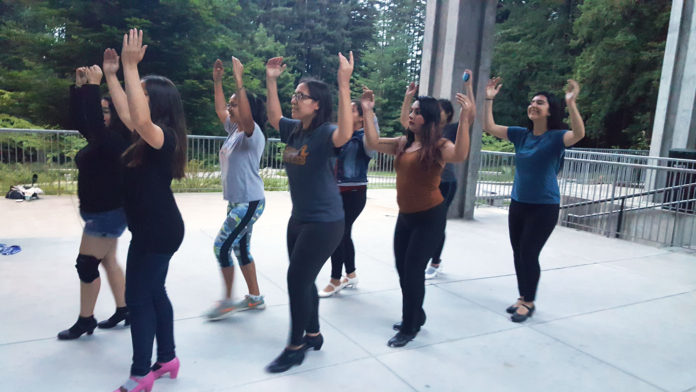The sign-ups for the Office of Physical Education, Recreation and Sports (OPERS) dance studio are posted every Monday at 10:30 a.m. Leaders of dance groups independent of OPERS scramble to sign up for a practice time and showing up 10 minutes late could cost them the space for the week.
The OPERS dance studio is the only studio on campus available for student-led groups to use for practice, but the space is prioritized for OPERS clubs and classes. Others can sign up to use it on a first-come, first-served basis for up to four hours a week. For some this is enough time but others need longer — especially in weeks leading up to a performance. Many groups say their need for a space is often a last priority across campus.
“We should be seen as just as important as the fitness classes and all the other things that are offered there,” said Paola Gomez, second-year events coordinator for Grupos Folklóricos Los Mejicas, a Mexican folk dance group. “We should definitely be more acknowledged.”
Recreation and physical education classes and OPERS sports clubs, such as the UC Santa Cruz dance team and the tango dance club, are penciled into the dance studio schedule before it’s opened to independent or Student Organization Advising and Resources (SOAR) groups like Haluan Hip-Hop Dance Troupe, Sabrosura Latin Dance Troupe, Los Mejicas, POPreKa and Kahaani.
With a current student body of over 17,000, OPERS’ 30-year-old facilities cannot accommodate all dance groups at UCSC. Dustin Smucker, the associate director of recreation at OPERS, said the lack of space needs to be addressed on a large scale through expansion of the facilities.
“The needs of students are palpable and real and the more that those concerns are brought up, the more it raises the issue of some way to address the need,” Smucker said. “Hearing the demand is the first step to being able to address it.”
OPERS has a negative carryforward of almost $800,000, but Smucker said that doesn’t limit the possibility for plans that could lead to an expansion of the facilities.
“There is a budget plan to pay down that deficit and I think it would be realistic to concurrently also have feasibility studies completed to think about expanding these facilities,” Smucker said.
He said expansion of the facilities, if it happens at all, will take time. Meanwhile dance groups are still searching for space. If they can’t get enough practice time within OPERS, they use any spaces they can get.
“In the end, we end up having to do whatever we have to do in order for our performance[s] to look great and presentable,” said third-year Sabrosura chair Natasha Lachica.
While some groups wear layers of clothing and practice on cardboard on cold winter nights at the Core West Parking Structure, others look to Social Sciences 1 or campus lounges. Many of these places are unsuitable for practice and lead to injuries or illness from practicing outside in the cold.
“I always wonder how much more full out we could be going, how much more my dancers could be growing if we had just a floor and a mirror,” said Ajani Thompson, co-coordinator for Haluan. Haluan’s main dance space is the parking garage. “I find that it really does hurt team morale. It’s so hard, it’s sometimes like pulling teeth with the practices.”
Sabrosura prefers not to practice outside but runs into other problems. Last year, the group practiced in the Porter I lounge, but this year because of increased enrollment and the conversion of dorm lounges into rooms, all other lounges on campus are reserved for studying.
Groups jump from one space to the next and practice until they are asked to leave.
“It just sucks having to go out of your way to at least try and get space to practice in,” Lachica said. “I don’t think it’s fair and I feel like the university should accommodate all the dance groups and find a way for us to fulfill our passion.”
Dance groups at UCSC don’t just exist to perform — they are often spaces of culture, family and growth. Coming to college is a new and difficult experience for many and for dancers, finding a community to dance with is like finding a home away from home.
“[Los Mejicas] really became a retention space for me and that’s why I continue to go back and I dedicate all of my time,” Paola Gomez said. “Without that space I would not be at this university right now.”
Dance group members not only practice together, but have family bonding activities and create lasting relationships that extend beyond dance practice and even college, Natasha Lachica said. For Lachica, being part of a Latin dance troupe also helped her retain her Spanish-speaking skills in college and learn about other Latin American cultures through other dance genres.
“I joined something that […] exposed me to other genres and other cultures that I didn’t know about,” Lachica said. “I think that’s the most interesting thing, […] you don’t just stay in that little bubble that maybe you knew from back home.”
Members in dance groups also gain opportunities for professional and scholastic development through participating in competitions, networking with alumni and taking on leadership roles within the groups.
In the end, dance is a different experience for every dancer.
“When you dance you can kind of release yourself in that moment,” Ajani Thompson said, “and you can kind of forget about all the things that are happening and just focus on the thing you love to do.”

